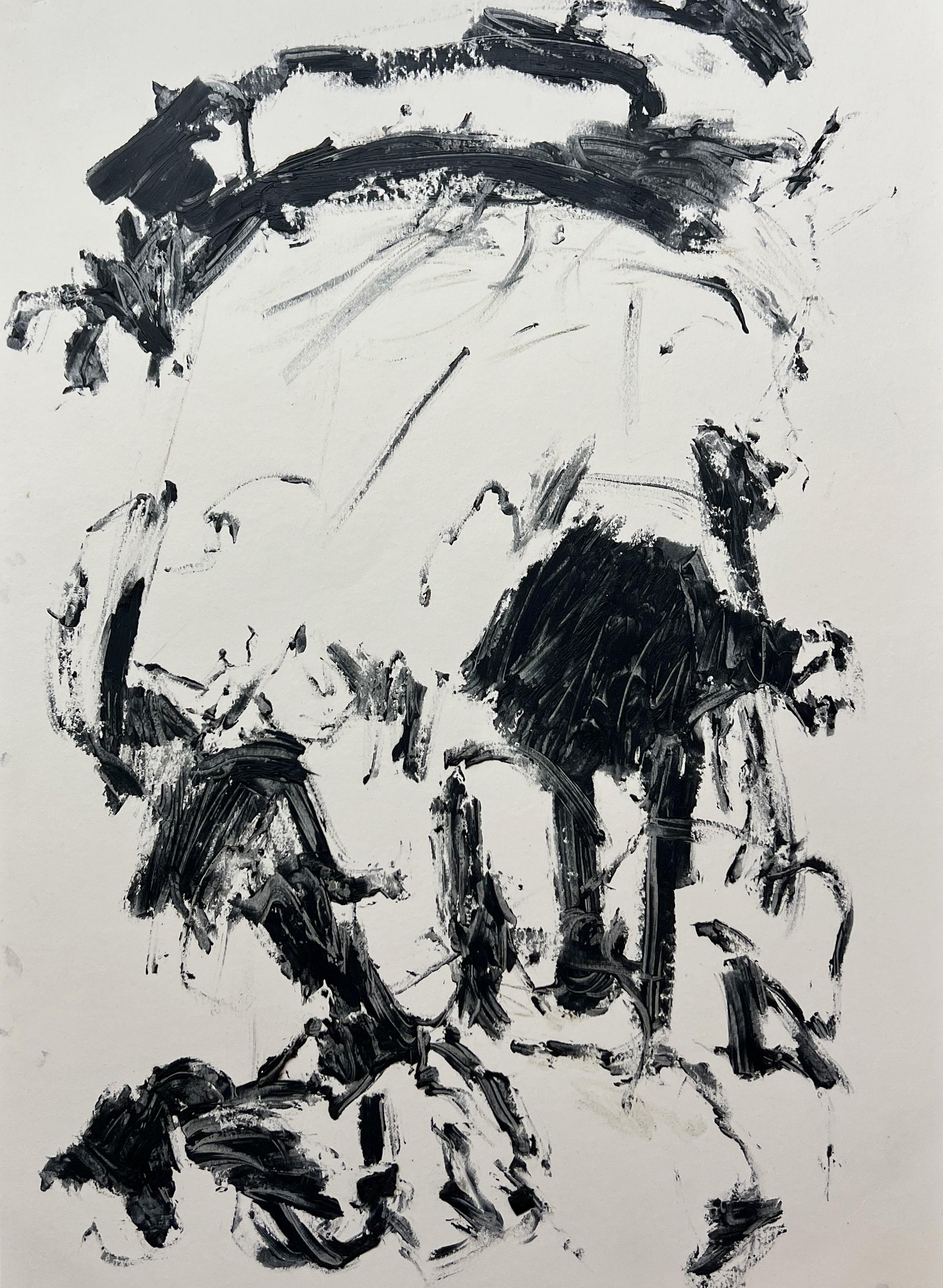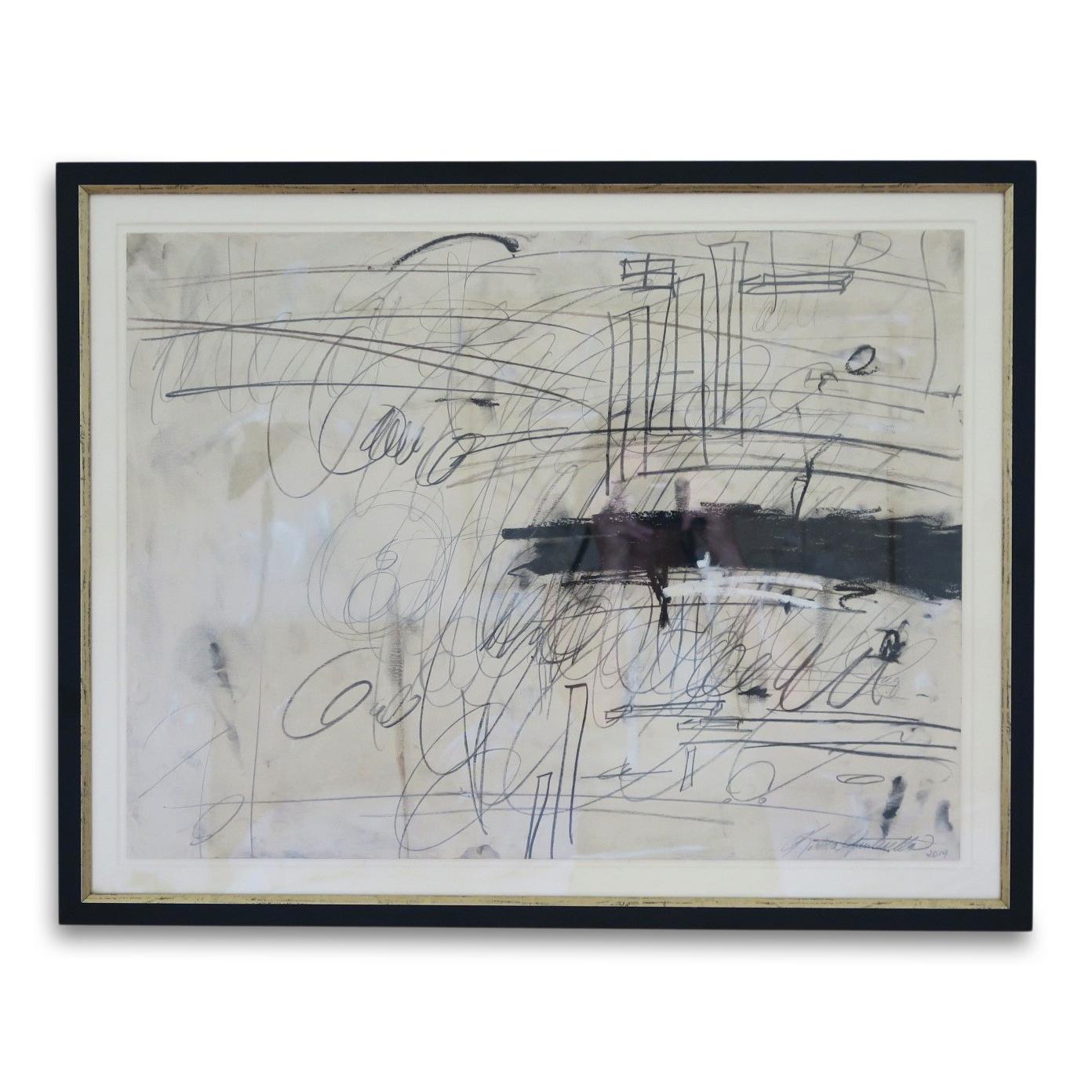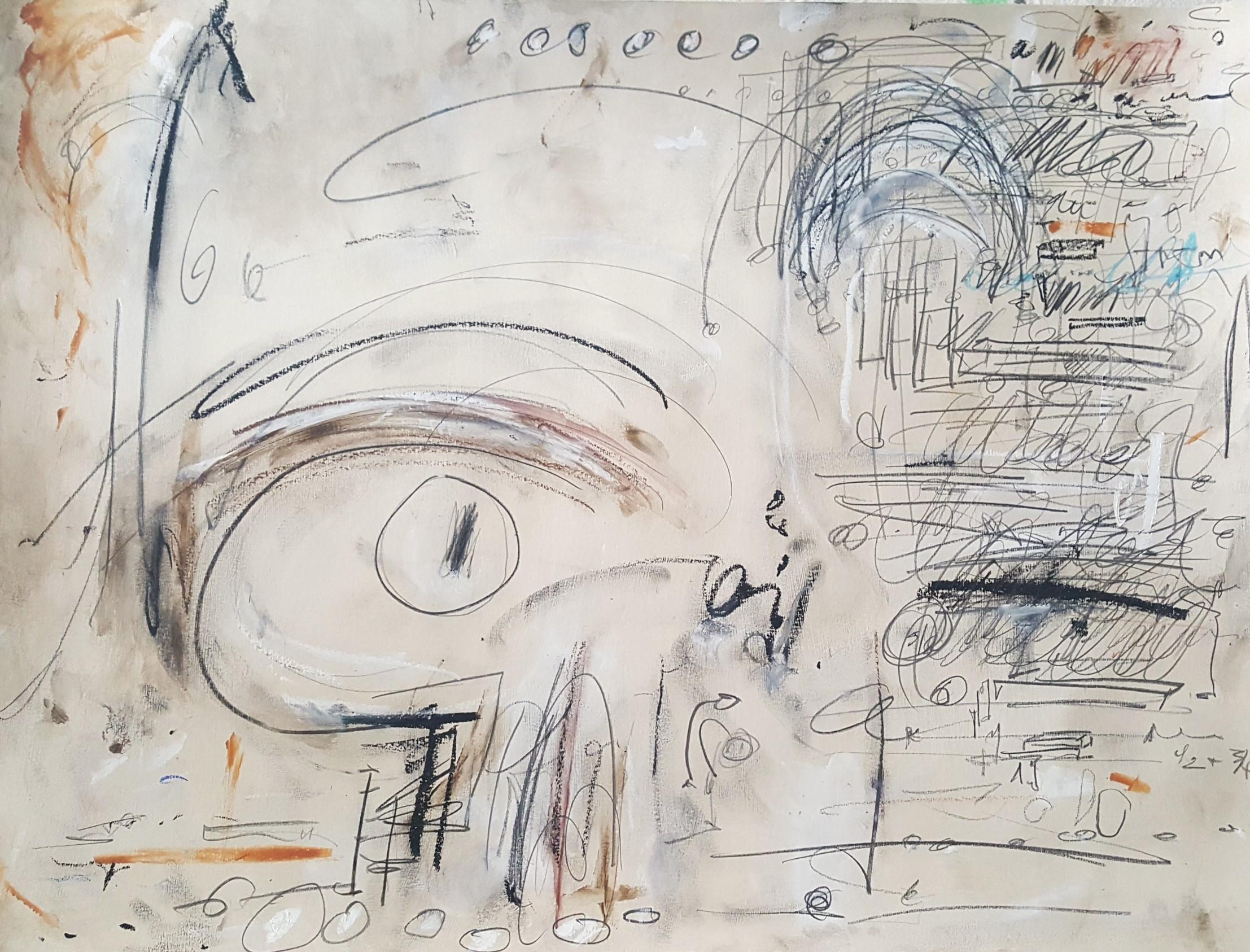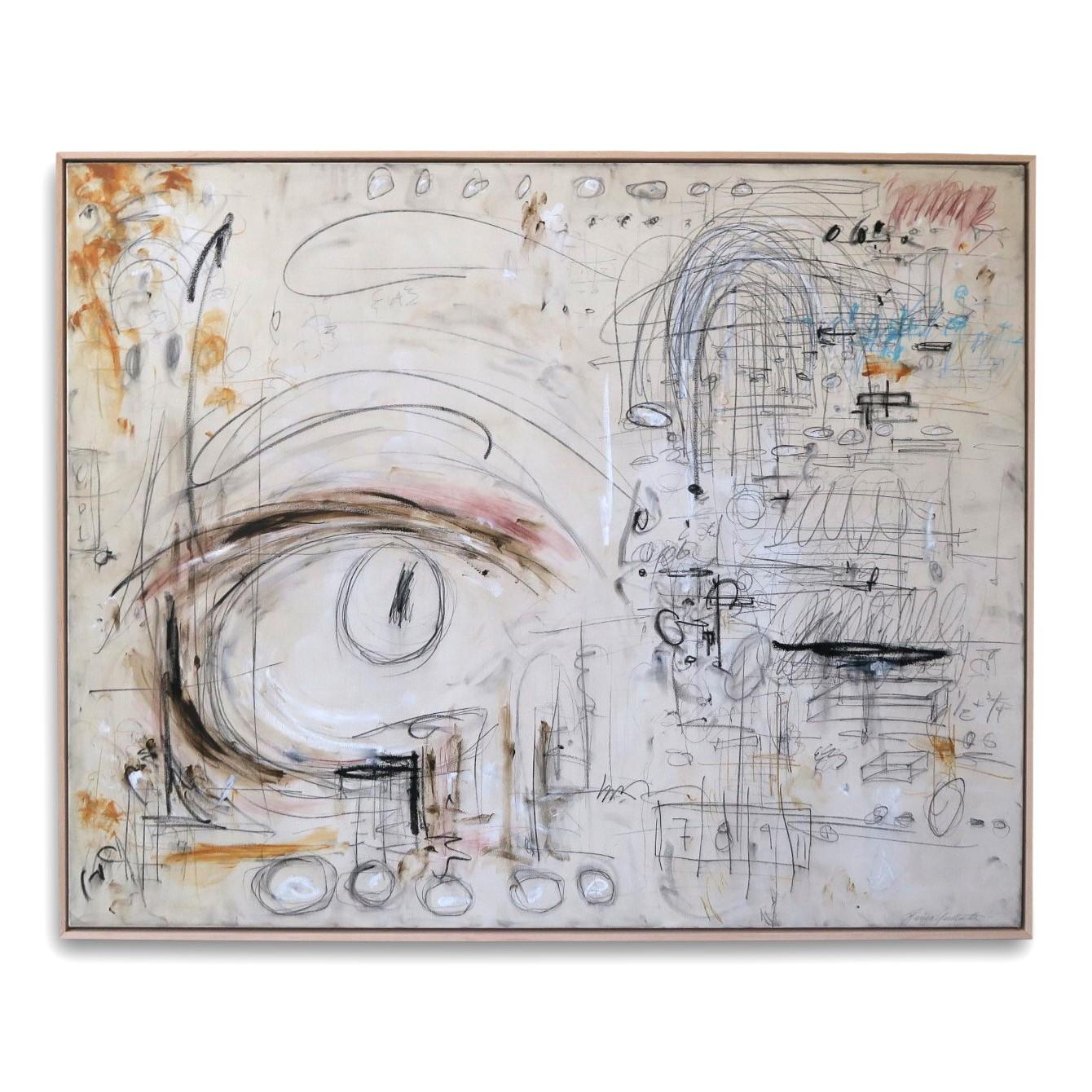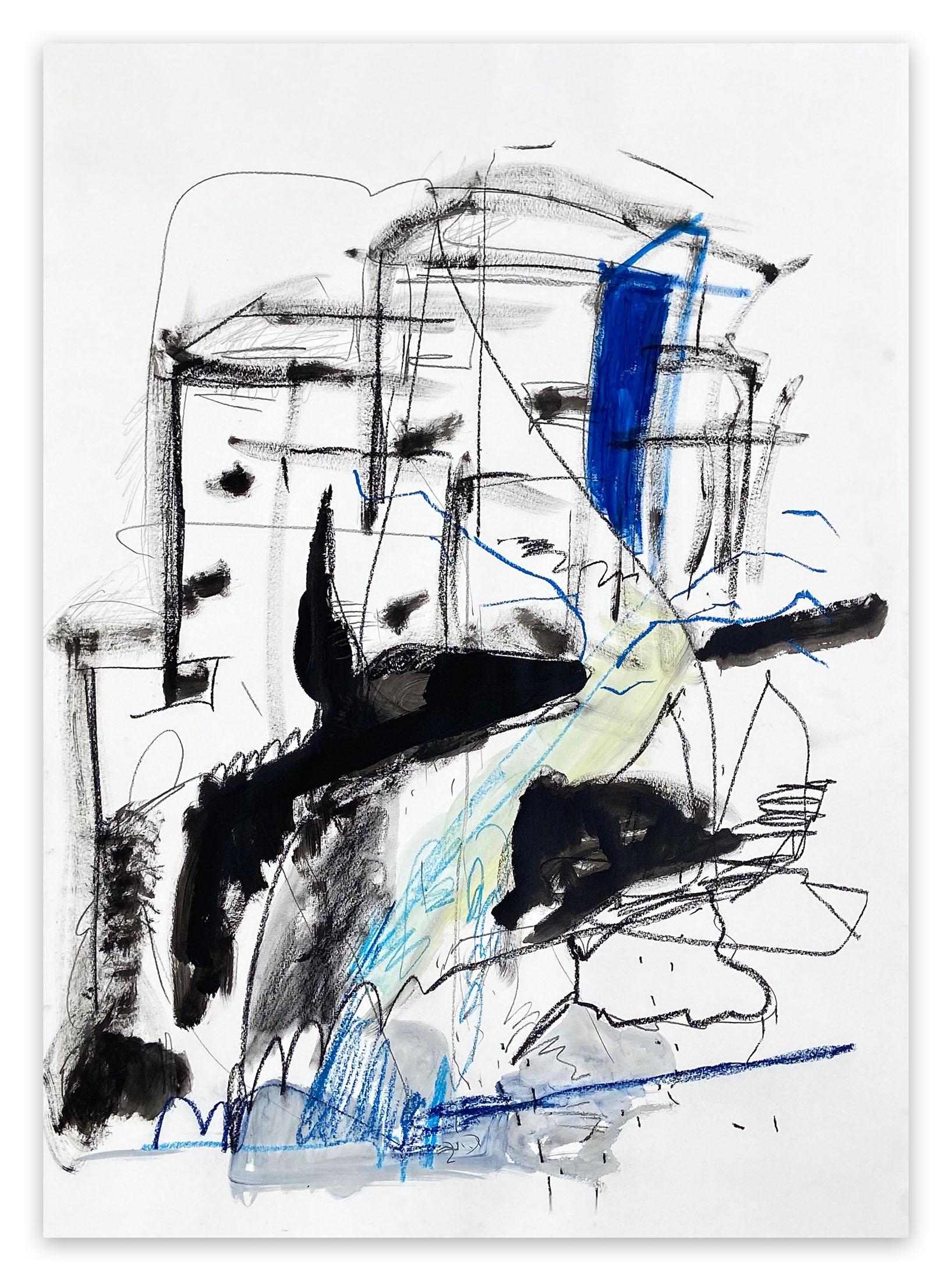Items Similar to Large Colorful Modernist Pastel Abstract Expressionist Painting Sylvia Carewe
Want more images or videos?
Request additional images or videos from the seller
1 of 14
Sylvia CareweLarge Colorful Modernist Pastel Abstract Expressionist Painting Sylvia Carewe
About the Item
Framed 33 X 45.5 image is 29 X 41.5
Hand signed lower left
Signed and titled verso
Sylvia Carewe (1906-1981) was an American woman artist, painter, writer and poet.
Born in New York City to Russian immigrant parents, Louis and Esther Kerewsky, she changed her surname to "Carewe" in 1930. Carewe attended Columbia University and studied further with Yasuo Kuniyoshi at Atelier 17 in New York, with Hans Hoffman in New York and Provincetown, Massachusetts, and at the New School for Social Research.
During World War II Carewe worked as an advertising copywriter and artist for agencies in New York. She became a prolific abstract artist in a range of media, including tapestry designs for the Aubusson tapestry carpet company in France, felt banners, collage reliefs, and what she termed "blown paintings," which were assemblages (predominantly of children's toy components) overlaid with spray paint. One of the most common subjects in her semi abstract paintings was New York City at night. She also worked in traditional artistic media, including watercolors, oils, lithographs and pastels. In October 1944, she married Marvin Small (formerly Smalheiser, executive for Carter's Little Liver Pills). They had one child, John Marvin, in June 1947.
Carewe had her first one-woman show in Poughkeepsie in 1947, after which she opened in New York City at the ACA Gallery in 1948. She had some twenty other American solo shows and her works hung in many exhibits across the United States as well as in France, Belgium and the Netherlands. Her works are represented in the permanent collections of the Whitney Museum, Musée de l'Arte Moderne, Paris, Brandeis University, the Butler Art Institute, Howard University, the Tel Aviv Museum and the National Museum in Djakarta, Indonesia. Her work has been described by French critics as "violent, colorful art, in hard contrasts, not exempt from cold lyricism." ["Les Girls," Time, 11 Nov 1957] Carewe was nearly as productive as a writer, producing both poetry and short stories. She corresponded with Milton Avery, Sally Avery, David Burliuk, Chaim Gross, and Abraham Walkowitz. She was photographed by Arnold Newman.
She was a founding member of The American Society of Tapestry Designers.
Carewe had three solo exhibitions at ACA Gallery (1948, 1950, 1953), the first as a result of winning an annual competition. During these early years, her paintings were very boldly colored, figurative abstractions executed in a primitive style, which mostly captured the locales from her frequent travels. Carewe was largely self-taught and had brief instruction with Hans Hofmann and Yasuo Kuniyoshi. Between January 1953 and May 1954, she worked at Atelier 17 and made several etchings, which she showed at The Three Arts in March 1954. Dorothy Dehner and Irene Rice Pereira were close friends of Carewe’s at this time, and it is possible that one of them may have introduced her to Atelier 17 (Stanley William Hayter). Two rare impressions of Carewe’s early etchings, likely created at Atelier 17, evidence her experimentation with printmaking techniques. In the first, Ebb and Flow (1953), Carewe dribbled stop-out varnish abstractly onto the plate and completed it by etching a spiral design into the white circle and lines into the crescent shape. This work was a forerunner to a tapestry design, La Firmament, that Carewe would create in the late 1950s and early 1960s with Braquenie & Cie, the renown weaver in Aubusson, France. The second, At Anchor (1954), features a very primitive, nocturnal composition of several boats and buoys rocking on the waves—a frequent motif of Carewe’s work through several media.
Carewe continued to create prints through the late 1950s, expanding the complexity of her designs and also trying her hand at lithograph printing, though she turned her focus increasingly to nocturnal paintings and drawings of city lights, and, more importantly, tapestry design. Encouraged by Katia Granoff, who represented the artist’s work in Paris, Carewe was one of the earliest modern artists—and one of the first women—to adopt the historic art form, a precursor to the explosion of modern tapestry manufacture during the 1960s and 1970s. She worked under the sponsorship of the French cultural attaché and created original cartons for her tapestry designs, which were produced with Braquenié & Cie. Represented by French & Company in New York, Carewe’s tapestries were well received, and JFK and Jacqueline Kennedy purchased one for their apartment at the Carlyle Hotel. She was included in the seminal 1973 exhibition "Women choose Women" along Pat Adams, Pearl Amsel, Heléne Aylon, Alice Baber, Nell Blaine, Vija Celmins, Perle Fine, Audrey Flack, Mary Frank, Sonia Gechtoff, Dorothy Gillespie, Yvonne Jacquette, Buffie Johnson, Joyce Kozloff, Joan Mitchell, Alice Neel, Betty Parsons, Faith Ringgold, Joan Snyder, Nancy Spero and Pat Steir. In addition to the visual arts, Carewe was a prolific poet and writer of short stories. Her work was collected by Charles and Ray Eames and is in the permanent collection of the Metropolitan Museum of Art in New York City, the Museum of Modern Art (MoMA) and the Whitney Museum, and she received several awards from the French Government.
- Creator:Sylvia Carewe (1914 - 1981, American)
- Dimensions:Height: 33 in (83.82 cm)Width: 44.5 in (113.03 cm)
- Medium:
- Movement & Style:
- Period:
- Condition:good. needs new frame.
- Gallery Location:Surfside, FL
- Reference Number:1stDibs: LU38210576172
About the Seller
4.9
Platinum Seller
These expertly vetted sellers are 1stDibs' most experienced sellers and are rated highest by our customers.
Established in 1995
1stDibs seller since 2014
1,549 sales on 1stDibs
Typical response time: 1 hour
- ShippingRetrieving quote...Ships From: Surfside, FL
- Return PolicyA return for this item may be initiated within 3 days of delivery.
More From This SellerView All
- Modernist Abstract Expressionist Watercolor Painting Bauhaus Weimar ArtistBy Pawel KontnyLocated in Surfside, FLAbstract watercolor composition bearing the influence of the earlier color-block compositions of Paul Klee and Abstract Expressionist master Sam Francis. Pawel August Kontny, (Polish-German-American artist) He was born in Laurahuette, Poland, in 1923, the son of a wealthy pastry shop owner. In 1939 he began studying architecture in Breslau where he was introduced to the European masters and to the work of some of the German Expressionists, soon afterward banned as "degenerate artists" and removed from museums throughout Germany by the Nazi regime. His studies were interrupted by World War II. Drafted into the German army, traveling in many countries as a soldier, he sketched various landscapes but in 1945, he was captured and held as a prisoner of war in Italy. After the war, he studied at the Union of Nuremberg Architects to help design buildings to replace ones destroyed in the war. He recorded his impressions of the local population and the landscapes through his watercolors and drawings. Pawel Kontny thereafter moved to Nuremberg, Germany, becoming a member of the Union of Nuremberg Architects and helping to rebuild the city's historic center. He soon decided to concentrate on his professional art career. He married Irmgard Laurer, a dancer with the Nuremberg Opera. Pavel Kontny 's career as an artist was launched with his participation in an all German exhibition, held at the Dusseldorf Museum in 1952. He held one-man shows in Germany, Switzerland and the United States. During his trip to the United States in 1960, Kontny became instantly enamored with Colorado, and decided to relocate to Cherry Hills with his wife and two children. He quickly established himself in the local art community, being affiliated for a time with Denver Art Galleries and Saks Galleries. His subject matter became the Southwest. During this time he received the Prestigious Gold Medal of the Art Academy of Rome. His extensive travel provided material for the paintings he did using his hallmark marble dust technique. he also worked equally in pastel, watercolor, charcoal and pencil-and-ink. in a style which merged abstraction and realist styles, influenced by Abstract Expressionist painting and South Western American landscapes. In the early 1960s he was one of only a few European-born professional artists in the state, a select group that included Herbert Bayer (1900-1985), a member of the prewar Bauhaus in Weimar and Dessau, Germany, and Roland Detre (1903-2001), a Hungarian modernist painter. As a Denver, Colorado resident, Pavel Kontny exhibited at galleries and museums throughout the United States, Germany and Japan. There, he was inspired by frequent trips to Native American pueblos in the Southwest, as well as by the study of the Plains Indians of Montana and Wyoming. Over the years Kontny had a number of students and generously helped young artist by hosting exhibitions at his Cherry Hills home. For many years he generously donated his paintings to support charitable causes in Denver. Influences during his European years included German pastelist C.O. Muller, German Informel painter Karl Dahmen and Swiss artist, Hans Erni. In the early 1950s his painting style showed the influence of the Die Brücke (The Bridge), a group of German expressionist artists formed in Dresden in 1905 who had a major impact on the evolution of modern art in the twentieth century in Germany. By the middle of the decade his style incorporated more referential abstraction and total abstraction, resulting in part from his study of Hans Hartung, a German artist based in Paris who exhibited his gestural abstract work in Germany. The American moon landing in 1969 inspired Paul Kontny...Category
20th Century Abstract Expressionist Abstract Drawings and Watercolors
MaterialsWatercolor, Archival Paper
- Modernist Abstract Expressionist Watercolor Painting Bauhaus Weimar Pawel KontnyBy Pawel KontnyLocated in Surfside, FLAbstract watercolor composition bearing the influence of the earlier color-block compositions of Paul Klee. Pawel August Kontny, (Polish-German-American artist) He was born in Laurahuette, Poland, in 1923, the son of a wealthy pastry shop owner. In 1939 he began studying architecture in Breslau where he was introduced to the European masters and to the work of some of the German Expressionists, soon afterward banned as "degenerate artists" and removed from museums throughout Germany by the Nazi regime. His studies were interrupted by World War II. Drafted into the German army, traveling in many countries as a soldier, he sketched various landscapes but in 1945, he was captured and held as a prisoner of war in Italy. After the war, he studied at the Union of Nuremberg Architects to help design buildings to replace ones destroyed in the war. He recorded his impressions of the local population and the landscapes through his watercolors and drawings. Pawel Kontny thereafter moved to Nuremberg, Germany, becoming a member of the Union of Nuremberg Architects and helping to rebuild the city's historic center. He soon decided to concentrate on his professional art career. He married Irmgard Laurer, a dancer with the Nuremberg Opera. Pavel Kontny 's career as an artist was launched with his participation in an all German exhibition, held at the Dusseldorf Museum in 1952. He held one-man shows in Germany, Switzerland and the United States. During his trip to the United States in 1960, Kontny became instantly enamored with Colorado, and decided to relocate to Cherry Hills with his wife and two children. He quickly established himself in the local art community, being affiliated for a time with Denver Art Galleries and Saks Galleries. His subject matter became the Southwest. During this time he received the Prestigious Gold Medal of the Art Academy of Rome. His extensive travel provided material for the paintings he did using his hallmark marble dust technique. he also worked equally in pastel, watercolor, charcoal and pencil-and-ink. in a style which merged abstraction and realist styles, influenced by Abstract Expressionist painting and South Western American landscapes. This one is influenced by California Abstract Expressionist artist Sam Francis. In the early 1960s he was one of only a few European-born professional artists in the state, a select group that included Herbert Bayer (1900-1985), a member of the prewar Bauhaus in Weimar and Dessau, Germany, and Roland Detre (1903-2001), a Hungarian modernist painter. As a Denver, Colorado resident, Pavel Kontny exhibited at galleries and museums throughout the United States, Germany and Japan. There, he was inspired by frequent trips to Native American pueblos in the Southwest, as well as by the study of the Plains Indians of Montana and Wyoming. Over the years Kontny had a number of students and generously helped young artist by hosting exhibitions at his Cherry Hills home. For many years he generously donated his paintings to support charitable causes in Denver. Influences during his European years included German pastelist C.O. Muller, German Informel painter Karl Dahmen and Swiss artist, Hans Erni. In the early 1950s his painting style showed the influence of the Die Brücke (The Bridge), a group of German expressionist artists formed in Dresden in 1905 who had a major impact on the evolution of modern art in the twentieth century in Germany. By the middle of the decade his style incorporated more referential abstraction and total abstraction, resulting in part from his study of Hans Hartung, a German artist based in Paris who exhibited his gestural abstract work in Germany. The American moon landing in 1969 inspired Paul Kontny...Category
20th Century Abstract Expressionist Abstract Drawings and Watercolors
MaterialsWatercolor, Archival Paper
- Irene Rice Pereira Modernist Gouache Drawing Painting Abstract Expressionist ArtBy Irene Rice PereiraLocated in Surfside, FLIrene Rice Pereira, Mixed Media on Paper (American, 1902-1971) Titled "The East Wind Carries the Seed" Hand signed l.r. "I. Rice Pereira". Paper: 14.1/8"h x 18.25"w Irene Rice Pe...Category
Mid-20th Century Abstract Expressionist Abstract Paintings
MaterialsPaper, Gouache
- Mod Abstract Expressionist W/C Painting Bernard Segal New Hope PA Modernist ArtLocated in Surfside, FLFramed 19 x 26. Image 14 X 21 Bernard Segal was born in Cincinnati, Ohio and attended Cincinnati University and the Cincinnati Art Academy. He was known for figure, abstract painting, collage, and cartoon illustration. In the 1920's and 30's, he lived in NYC and attended The Art Students League where he was creative with a number of artistic styles of the period. During WWII, he worked as a cartoonist for a government issued newspaper called 10-SHUN that was published in Greensboro, NC. Bernard worked under the pen name Seeg, and was the author of the comic strip "Hank and Honey," that appeared in the New York Herald Tribune from the 1940's through the 50's. This cartoon was syndicated and published in Quebec under the title "Louise et Louis." The strip was later retitled to Ellsworth. Segal also illustrated a number of Jewish books that were published by the Union of American Hebrew Congregations, and Bible stories. In the 1950's Segal moved to Bucks County, Pennsylvania, and became a member of the New Hope Modernists. He worked with esteemed artists such as George Nakashima, Charles Evans, Louis Stone, Lloyd ney, josef Zenk, Clarence Carter and Charles Ramsey. Segal's most noted work was made during the 1960's, during which time he produced paintings and collages in the abstract expressionist style. He enjoyed painting bright abstract oil...Category
1960s Abstract Expressionist Abstract Paintings
MaterialsPaper, Watercolor
- David Kimball Anderson Large Oil Stick Pastel Abstract Flowers DrawingBy David Kimball AndersonLocated in Surfside, FLLarge bright vivid drawing done in oil crayon or oil pastel. Abstract floral drawing. David Kimball Anderson’s work is bold and graceful, respectful and spiritual. A practicing Bud...Category
1970s Contemporary Abstract Drawings and Watercolors
MaterialsPaper, Oil Crayon, Oil Pastel
- Abstract Expressionist Gestural Oil Pastel Drawing Women Figures Anthony TrianoLocated in Surfside, FLAnthony Thomas Triano (1928–1997) was an abstract expressionist painter, sculptor, illustrator and teacher. His works feature natural forms, especially the human form, and tend towar...Category
1960s Abstract Expressionist Abstract Drawings and Watercolors
MaterialsPaper, Oil Pastel
You May Also Like
- "Untitled" Acrylics, Pencil, Oil Pastels on Paper in Hues of Black and WhiteBy Karina GentinettaLocated in New York, NY"Untitled" 2019, 28" x 22" horizontal drawing on paper by Argentine-born artist Karina Gentinetta (featured in Elle Decor, the New York Times, Tradi...Category
21st Century and Contemporary Abstract Expressionist Abstract Drawings a...
MaterialsGlaze, Acrylic, Oil Pastel, Carbon Pencil
- "Untitled" Acrylics, Pencils, Oil Pastels on Paper in Neutral Hues of TaupeBy Karina GentinettaLocated in New York, NY"Untitled" 2019, 25" x 31" horizontal drawing on paper by Argentine-born artist Karina Gentinetta (featured in Elle Decor, the New York Times, Tradi...Category
21st Century and Contemporary Abstract Expressionist Abstract Drawings a...
MaterialsGlaze, Oil Pastel, Acrylic, Carbon Pencil
- "Eye of the Beholder" Acrylics, Pencils, Oil Pastels in Neutral Hues of TaupeBy Karina GentinettaLocated in New York, NY"Eye of the Beholder" 2024, 48"x60" horizontal abstract painting by Argentine-born artist Karina Gentinetta (featured in Elle Decor, Architectural Digest, the New York Times, Traditi...Category
21st Century and Contemporary Abstract Expressionist Abstract Drawings a...
MaterialsOil Pastel, Acrylic, Carbon Pencil, Color Pencil
- Contemporary Abstract Expressionist Painting, Unique piece oil on paperLocated in Carballo, ES"Forest Lights" is an abstract painting by TUSET. It is a beautiful abstract architectural painting of unique blurry shapes brushstrokes. The painting was made with oil crayon on wat...Category
21st Century and Contemporary Abstract Expressionist Abstract Drawings a...
MaterialsPaper, Oil Crayon
- Nordic waves (Abstract painting)By Adrienn KrahlLocated in London, GBNordic waves (Abstract painting) Acrylic, charcoal, oil pastel and graphite on paper - Unframed. Artwork exclusive to IdeelArt. Adrienn Krahl’s paintings express a profound sense ...Category
2010s Abstract Abstract Paintings
MaterialsPaper, Charcoal, Oil Pastel, Acrylic, Graphite
- Nordic waves (Abstract painting)By Adrienn KrahlLocated in London, GBNordic waves (Abstract painting) Acrylic, charcoal, oil pastel and graphite on paper - Unframed. Artwork exclusive to IdeelArt. Adrienn Krahl’s paintings express a profound sense ...Category
2010s Abstract Abstract Paintings
MaterialsPaper, Charcoal, Oil Pastel, Acrylic, Graphite
Recently Viewed
View AllMore Ways To Browse
Large Colorful
Colorful Vintage Art
Large Painting Paris
Painting Pastels Signed
Colorful Retro Art
Retro Abstract Expressionist Painting
Large Art Colorful
Large Modern Abstract Painting
Large Black Abstract Paintings
Three Large Paintings
Very Large Abstract
Modernist Abstract Paintings
Large Modern Art Abstract Painting
Modern Colorful Painting
Abstract Modernist Art
Early Expressionist Painting
Large Expressionist
Very Large Abstract Art
